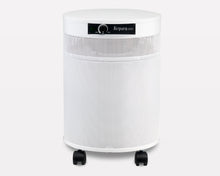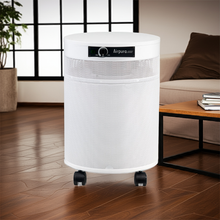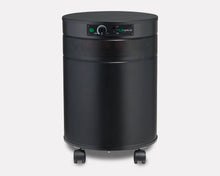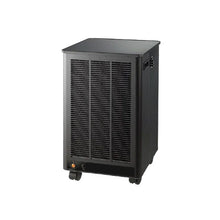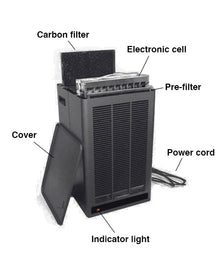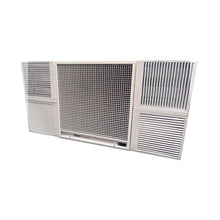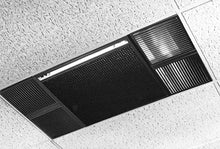Can Air Purifiers Really Remove Thirdhand Smoke Residue in Businesses?

The subtle, yet unmistakable, scent of stale cigarettes or lingering vape permeates spaces long after the smoke itself has cleared. This isn't just an unpleasant odor; it's a phenomenon known as "thirdhand smoke" (THS). For businesses, particularly those that once allowed smoking or have inherited a history of it, THS presents a significant challenge. It deters new customers, creates an unhealthy environment for employees, and can even compromise product quality. The question then arises: can commercial air purifiers truly tackle "thirdhand smoke removal commercial" challenges, including persistent "nicotine residue" and the pervasive "clean surfaces smoke smell"?
At Commercial Air Purifiers, LLC, we frequently encounter business owners grappling with this invisible foe. Many assume that once smoking ceases, the problem disappears, but the reality is far more complex. THS is a stubborn, insidious pollutant. While no single solution offers a magic bullet for complete remediation in deeply contaminated spaces, we unequivocally state that advanced, commercial-grade air purification plays a crucial, ongoing role in mitigating and managing thirdhand smoke, particularly in conjunction with thorough surface cleaning. This article will unpack the science behind thirdhand smoke, explain how specialized air purifiers contribute to its removal, and offer practical strategies for businesses committed to creating truly fresh and healthy indoor environments.
The Persistent Problem: Understanding Thirdhand Smoke
Thirdhand smoke (THS) is the chemical residue from tobacco smoke that settles on surfaces and lingers in dust and on materials long after a cigarette, cigar, or pipe has been extinguished. It's not just the smell; it's a complex mixture of chemicals, including nicotine, tobacco-specific nitrosamines (TSNAs), and other volatile organic compounds (VOCs). These residues can react with common indoor pollutants to form new, even more toxic compounds over time.
Why is THS such a stubborn problem?
-
Adsorption to Surfaces: Unlike secondhand smoke, which is airborne, thirdhand smoke's toxic components adsorb (stick) to porous and non-porous surfaces alike. This includes walls, ceilings, carpets, furniture, fabrics, curtains, electronics, and even hard surfaces like glass and metal.
-
Re-emission (Off-gassing): Once adsorbed, these chemicals don't just stay put. They can slowly "off-gas" or re-emit back into the air over weeks, months, or even years, perpetuating the "clean surfaces smoke smell" even after initial cleaning attempts. This phenomenon makes passive exposure a real concern.
-
Chemical Reactions: Nicotine, a primary component of THS, can react with indoor oxidants like nitrous acid (from gas appliances or outdoor air pollution) to form potent carcinogens such as N-nitrosamines, including NNK (nicotine-derived nitrosamine ketone) and NNA (nicotine-derived nornicotine). Research from institutions like Lawrence Berkeley National Laboratory has highlighted these harmful chemical reactions.
-
Health Risks: Exposure to thirdhand smoke has been linked to various health problems, particularly in vulnerable populations like children, whose developing bodies and frequent contact with contaminated surfaces make them highly susceptible. Health effects can include respiratory problems, DNA damage, and an increased risk of cancer.
For a business, this means that merely opening windows or using air fresheners is woefully inadequate. The "nicotine residue" on surfaces continues to be a source of contamination, requiring a multi-pronged approach that addresses both airborne and surface-bound pollutants.
The Role of Commercial Air Purifiers in Thirdhand Smoke Remediation
It's crucial to clarify: air purifiers alone cannot remove thirdhand smoke that has permeated surfaces and materials. That requires physical cleaning, sealing, and sometimes even replacement of contaminated materials. However, commercial-grade air purifiers play a critical and active role in mitigating THS by continuously removing the chemicals that off-gas from surfaces back into the air. They act as a vital line of defense against the re-aerosolization of these harmful compounds.
Here's how advanced commercial air purifiers contribute to "thirdhand smoke removal commercial" strategies:
1. Robust Activated Carbon Filtration: The Primary Weapon Against Off-Gassing VOCs
The core technology for combating thirdhand smoke's gaseous components and lingering odors is activated carbon. Unlike standard air purifiers that might contain a thin layer of carbon, commercial-grade units designed for smoke remediation feature substantial beds of specialized activated carbon.
-
Mass Matters: A commercial "air purifier nicotine residue" solution will contain pounds – often 20 to 40+ lbs – of high-quality activated carbon. This sheer volume provides an enormous surface area for adsorption, allowing the carbon to capture and hold a significant quantity of gaseous chemicals.
-
Specialized Impregnation: For smoke, carbon is often impregnated with chemicals like potassium iodide or potassium permanganate. These impregnations enhance the carbon's ability to chemically react with and neutralize a broader spectrum of harmful VOCs, aldehydes, and other gaseous pollutants common in THS, rather than just passively adsorbing them.
-
Continuous Capture: As THS chemicals off-gas from surfaces into the air, the air purifier's powerful fan draws this contaminated air through the carbon filter, where the gaseous pollutants are adsorbed. This continuous process actively reduces the concentration of re-emitted thirdhand smoke chemicals in the breathing zone.
-
Expert Insight from Commercial Air Purifiers, LLC: In our experience with businesses that have inherited spaces with heavy smoking histories (e.g., former cigar lounges converted to retail), the most noticeable and lasting improvement in air quality and odor reduction comes directly from high-capacity activated carbon filtration. It's a marathon, not a sprint, but the consistent removal of off-gassing compounds is indispensable. We've seen customer feedback where the initial visible "clean surfaces smoke smell" persists until a commercial-grade air purifier with significant carbon is introduced and run continuously for weeks.
2. True HEPA Filtration: Capturing Re-aerosolized Particulates
While activated carbon handles gases, a True HEPA filter addresses the particulate component of thirdhand smoke.
-
Microscopic Particles: THS residue on surfaces can be disturbed and re-aerosolized into the air as microscopic particles (e.g., from walking on carpets, dusting, or even just air currents). These particles, often within the ultrafine range (PM2.5 and smaller), still carry toxic compounds.
-
HEPA Efficiency: A True HEPA filter is certified to capture 99.97% of particles 0.3 microns in size. This effectively traps the vast majority of re-suspended THS particulates, preventing them from being inhaled.
3. High Air Changes Per Hour (ACH): Accelerating Mitigation
For effective "thirdhand smoke removal commercial" strategies, the air purifier's ability to process a large volume of air quickly is crucial.
-
CFM & ACH: Commercial air purifiers have high Cubic Feet per Minute (CFM) ratings, translating to a high number of Air Changes Per Hour (ACH). This means the entire volume of air in the space is filtered multiple times per hour, rapidly drawing off-gassing chemicals and re-suspended particles into the filtration system.
-
Faster Remediation: In spaces with significant THS, aiming for 4-6+ ACH with a powerful commercial unit (running 24/7 initially) can significantly accelerate the reduction of airborne THS components.
A Comprehensive Approach: Beyond Air Purification
While commercial air purifiers are a vital tool, they are part of a larger strategy for true "thirdhand smoke removal commercial." For businesses, particularly those inheriting severely contaminated spaces, we recommend a multi-faceted approach:
-
Deep Cleaning of All Surfaces: This is the foundational step.
-
Washable Surfaces: Thoroughly clean all hard, washable surfaces (walls, ceilings, floors, non-porous furniture) with heavy-duty degreasers and cleaning solutions. Products containing Trisodium Phosphate (TSP) are often recommended by professional remediation services for cutting through tar and nicotine residue.
-
Fabrics & Upholstery: All soft furnishings, curtains, carpets, and upholstery absorb THS like sponges. Professional steam cleaning or specialized upholstery cleaning is often necessary. In severe cases, replacement of heavily contaminated items (e.g., carpets, drapes, mattresses) may be the only effective solution, as the residue can be deeply embedded.
-
HVAC System & Ductwork: The HVAC system itself can become a reservoir for THS. Professional duct cleaning is essential, and all HVAC filters (furnace filters) should be replaced with high-MERV (MERV 13+) filters to capture remaining particulates.
-
-
Sealing Porous Surfaces: After cleaning, consider sealing porous surfaces like drywall, wood, and concrete with odor-blocking primers and paints. These specialty primers create a barrier that can encapsulate remaining "nicotine residue" and prevent off-gassing into the air.
-
Continuous Commercial Air Purification: Once the deep cleaning and sealing are complete, deploy commercial-grade air purifiers with substantial activated carbon and True HEPA filtration. Run these units continuously, especially for the first few weeks or months, to actively remove any remaining off-gassing chemicals.
-
Placement Strategy: Strategically place units to maximize air circulation. For larger businesses, multiple powerful portable units or an integrated HVAC solution may be necessary. For spaces with a history of very heavy smoking, consider dedicated "cigarette smoke eliminator commercial" units that are designed for continuous, high-load filtration.
-
-
Regular Maintenance: Consistency is key.
-
Frequent Filter Changes: Activated carbon filters will eventually become saturated with adsorbed chemicals and lose effectiveness. In environments with a history of heavy THS, these filters will likely need to be replaced more frequently than in typical settings. Pre-filters also need regular attention.
-
Ongoing Deep Cleaning: Maintain a rigorous cleaning schedule to prevent new buildup and re-aerosolization from surfaces.
-
-
Authoritative Support: The Thirdhand Smoke Resource Center at the University of California, San Francisco, a leading research institution on THS, emphasizes that deep cleaning, ventilation, and air filtration (specifically with activated carbon and HEPA) are crucial components of mitigation, though complete removal from heavily contaminated porous materials might be impossible without replacement.
Conclusion: A Breath of Fresh Air for Your Business
Thirdhand smoke is a persistent, complex challenge for businesses, extending far beyond a mere unpleasant odor. It represents a lingering health risk and a significant deterrent to customer satisfaction and employee well-being. While eradicating deeply embedded THS from materials can be a monumental task often requiring professional remediation, commercial-grade air purifiers offer an indispensable, active solution for "thirdhand smoke removal commercial" challenges.
By deploying systems with robust activated carbon and True HEPA filtration, businesses can continuously capture the harmful chemicals that off-gas from surfaces and re-enter the air. At Commercial Air Purifiers, LLC, we empower businesses to address this challenge head-on, ensuring that their spaces offer truly clean, fresh, and welcoming air. It's an investment in health, reputation, and the long-term success of your enterprise.
Frequently Asked Questions
Q1: How long does it take for an air purifier to remove the "clean surfaces smoke smell" from thirdhand smoke? A1: This depends heavily on the severity of the thirdhand smoke contamination and the power of the air purifier. If surfaces have been thoroughly cleaned and sealed, a commercial-grade air purifier with substantial activated carbon can significantly reduce airborne odors from off-gassing within days or weeks of continuous operation. For deeply embedded residue, it can be a continuous, ongoing process, but the reduction in airborne chemicals will be noticeable over time. It's a gradual mitigation, not an instant elimination.
Q2: Can I just paint over the "nicotine residue" to seal in the smell? A2: While a high-quality, odor-blocking primer (often shellac-based or specialized for smoke odors) followed by new paint can help encapsulate some of the surface-level nicotine residue and odors, it's not a foolproof solution, especially in heavily contaminated environments. The chemicals can still off-gas from deeper within porous materials or from unsealed areas. Painting should always follow a thorough deep cleaning, and even then, air purification remains crucial for handling any residual off-gassing.
Q3: Is it safe to be in a business while an air purifier is working on thirdhand smoke? A3: Yes, completely safe, provided the air purifier uses safe filtration technologies (True HEPA and activated carbon) and is certified ozone-free. Commercial Air Purifiers, LLC only recommends systems that meet these safety standards. The purifier is actively cleaning the air, making the environment healthier, not introducing any new risks.
Q4: Do I need a professional cleaning service before using an air purifier for thirdhand smoke? A4: For best results and to truly tackle "thirdhand smoke removal commercial" effectively, professional deep cleaning of all surfaces, fabrics, and potentially ductwork is highly recommended before or in conjunction with deploying commercial air purifiers. Air purifiers work by cleaning the air, but they cannot scrub walls or wash carpets. A thorough physical cleaning removes the bulk of the residue, allowing the air purifier to focus on capturing the off-gassing chemicals that continually re-enter the air.
About the Author: Commercial Air Purifiers, LLC is a leading provider of high-quality air purification solutions for commercial, industrial, and specialized residential environments. With years of experience and a deep understanding of airborne contaminants, we are dedicated to helping businesses and individuals achieve optimal indoor air quality. Our commitment to research-backed solutions and customer well-being drives our mission to bring the best air purifiers to the market.
Publication Date: July 21, 2025
References:
-
Thirdhand Smoke Resource Center. (n.d.). About Thirdhand Smoke. University of California, San Francisco. Retrieved from https://thirdhandsmoke.org/thirdhand-smoke-explained/about-ths/
-
Lawrence Berkeley National Laboratory. (2010, October 1). Thirdhand Smoke: New Evidence of Toxic Compounds and Risks. Retrieved from https://newscenter.lbl.gov/2010/10/01/thirdhand-smoke-new-evidence-of-toxic-compounds-and-risks/
-
Medical News Today. (2023, August 2). Getting rid of the smell of smoke: Cleaning tips and more. Retrieved from https://www.medicalnewstoday.com/articles/how-to-get-rid-of-cigarette-smell
-
Oransi. (n.d.). What is Thirdhand Smoke? Everything You Should Know. Retrieved from https://oransi.com/blogs/blog/thirdhand-smoke
-
Disaster Kleenup Specialists. (n.d.). Cigarette Smoke Removal & Cleaning | Monterey, CA. Retrieved from https://www.disasterkleen.com/cigarette-smoke-removal-cleaning/ (Discusses professional remediation techniques for thirdhand smoke).

